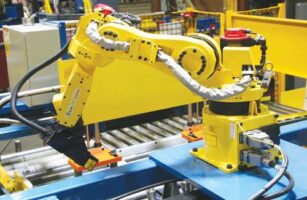BENEFITS AND CHALLENGES OF IMPLEMENTING CNC AUTOMATION IN MANUFACTURING
Benefits and Challenges of Implementing CNC Automation in Manufacturing
The implementation of Computer Numerical Control (CNC) automation in manufacturing has revolutionized the industry, offering a myriad of advantages and, at the same time, presenting some notable challenges. In this article, we will explore the key benefits and challenges associated with CNC automation.
Benefits of Implementing CNC Automation:
- Precision and Accuracy: CNC machines are renowned for their precision and accuracy. They can consistently produce high-quality, intricate components, ensuring products meet tight tolerances and quality standards.
- Increased Productivity: Automation reduces human error and enables continuous operation. CNC machines can run 24/7, increasing production efficiency and throughput.
- Cost Efficiency: While the initial investment in CNC machinery can be significant, the long-term cost savings are substantial. Reduced labor costs, lower scrap rates, and optimized material usage all contribute to cost efficiency.

- Versatility: CNC machines can be programmed to produce a wide range of parts, making them versatile for various manufacturing applications. This adaptability reduces the need for multiple specialized machines.
- Reduced Lead Times: CNC automation speeds up production cycles, reducing lead times for customers. Shorter lead times can give a company a competitive edge in the market.
- Enhanced Safety: Automation minimizes direct human involvement with dangerous machinery, improving workplace safety and reducing the risk of accidents.
- Quality Control: CNC machines allow for consistent quality control by eliminating variations caused by human factors. This results in improved product quality.
- Data Collection and Analysis: CNC automation systems can collect real-time data, enabling manufacturers to monitor and analyze performance, make data-driven decisions, and identify areas for improvement.
Challenges of Implementing CNC Automation:
- High Initial Investment: Acquiring and setting up CNC machines can be costly. Smaller manufacturers may find the initial investment challenging to manage.
- Skilled Labor Requirement: While automation reduces the need for manual labor, skilled operators are essential to program and maintain CNC machines. Finding and retaining such personnel can be a challenge.
- Downtime and Maintenance: Like any machinery, CNC systems require regular maintenance. Downtime for maintenance can disrupt production schedules, and maintenance costs can add up.
- Programming Complexity: CNC machines require skilled programmers to create and modify the machine’s code. Developing and maintaining this expertise can be a challenge for some manufacturers.
- Flexibility Constraints: While CNC machines are versatile, they may not be suitable for all manufacturing tasks. Adapting to different products or design changes can be cumbersome.
- Cybersecurity Risks: With the integration of CNC systems with computer networks, they become susceptible to cybersecurity threats. Protecting sensitive manufacturing data is crucial.

- Lack of Human Touch: The absence of the human touch can be a disadvantage when it comes to tasks requiring creativity or adaptability, which may limit certain manufacturing processes.
- Environmental Impact: The energy consumption of CNC machines and the disposal of electronic components can have environmental repercussions. Manufacturers need to consider their environmental footprint.
In conclusion, the benefits of implementing CNC automation in manufacturing are substantial, offering enhanced precision, productivity, and cost efficiency. However, challenges such as the initial investment, skilled labor requirements, and cybersecurity risks must be carefully addressed. Manufacturers must weigh these pros and cons to make informed decisions about adopting CNC automation in their operations.


